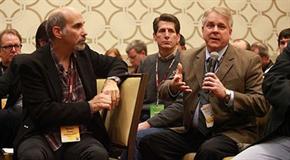Features
Pollstar Live! Worst-Case Scenario Survival
And that’s it. Audience member Don Graham of Nokia Theatre L.A. Live stood up at the end and told the audience that, in attending 15 years of the Pollstar conferences, this panel was the best and most important one he had ever attended. He tasked the audience with making sure it returned next year as a main session.
Moderator Stuart Ross began by listing the recent, and increasing, event accidents, or near accidents.
“Sugarland, Radiohead in Toronto, Ottawa Blues Festival, Pukkelpop, Electric Daisy in Los Angeles. Look. I don’t want to be dramatic but the subject matter forces me to be dramatic. One of my biggest fears is the next time one of these events occurs, the next time a stage collapses, kids are killed.
“When one of these completely avoidable situations occurs, it’s going to be our Newtown. Citizens will rightly demand from their elected officials, ‘How could this have happened? Why didn’t you do something about it?’ And the knee-jerk reaction will be some sort of government regulation. I want a way where we can work with our government officials to show them how responsible we can be.”

The Event Safety Alliance is an ad hoc organization with approximately 600 members composed of insurers, suppliers, IATSE members, weather officials and others. It released its Event Safety Guide last year, and is modifying it as living document. Jim Digby, production manager for Linkin Park, is executive director of ESA. Audience members were each provided a thumb drive containing the PDF of the safety guide, courtesy of John Brown, CEO of Brown United, who was in attendance.
On the panel was Charlie Hernandez, production manager for Farm Aid and The Police among other responsibilities; Matt Bettenhausen, chief of security for AEG Live and a former federal prosecutor; Berkeley Reinhold, head of music business affairs for WME and Ken Macdonald, a festival director as well as venue GM. The audience included Dr. Donald Cooper, retired chief deputy state fire marshal for Ohio, who constructed the language and compiled the standards for the guide.
The guide itself mirrors the U.K.’s “purple guide,” the manual of safety best practices born from the tragic crowd deaths at 1988’s Monsters of Rock festival. Using the U.S. version – first presented at last year’s conference – could go a long way toward keeping the government regulations at bay.
“I’ve spent most of my life in government,” Bettenhausen said. “You don’t want it in our business.” There are about 1,200 new laws in California and 40,000 nationwide annually, he noted.
“There are more than enough laws on the books for disasters,” he said. “The problem is awareness. We owe it to the fans to be safe. It’s part of the ticket price to have safe, secure events. If we don’t we’ll have 50,000 new regulations on our tours.”
The guide should go a long way toward eliminated the “cowboy culture” in the industry, as was noted.
“All agents and managers care about the safety of their clients,” Reinhold said. Adhering to these guidelines would have a “trickle down effect,” and agencies wouldn’t require language in their contracts to increase safety measures because they’re already in place.